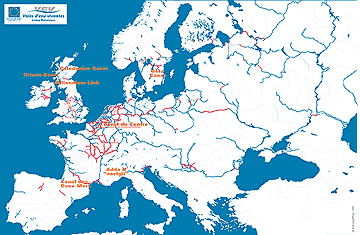| |
Most
of the canals and inland waterways in Europe experienced a deep-seated
change in purpose and use during the last decades of the 20th
century. Tools of the Industrial Revolution from the late 18th
century, they gradually became "historic", in other
words no longer adapted to the transport needs of our modern society,
but nonetheless representing an extraordinary heritage of navigation
structures, landscapes, operational buildings, down to the smallest
architectural detail, all testifying to the "golden age"
of expansion of industrial activities throughout Europe.
In addition to their importance as factors of regional identity,
canals are also unique ecosystems in their own right, which have
become increasingly fragile through the ravages of time, lack
of maintenance and the pressures of increasing leisure use.
Why maintain these structures as "living waterways" ?
Because they offer hundreds of millions of Europeans a whole range
of possibilities of leisure, tourism, cultural visits and discovering
the environment.
To this end, they have to be rehabilitated, maintained, their
structures operated. Just as important, they have to be promoted
to clients near and far.
Considering that canals thus entered the category of "endangered
river systems", according to the terms of the call for tenders
"TERRA - ERDF article 10" issued by the European Commission
in 1996, the Midi-Pyrenees regional council put together with
7 partner regions in Europe a collaboration project, which was
adopted by the Commission in March 1998 (along with 14 other transnational
projects). The project, named "Historic canals - living waterways"
(giving the French acronym "VEV" for "voies d'eau
vivantes") is currently being completed. It represents about
60 distinct actions Ñ studies, research projects, field experiments
Ñ carried out under the responsibility of the partner regions
and waterway authorities, thus pioneering new forms of transnational
collaboration between European regions.
The total budget of the TERRA/VEV project is 3,5 millions euros,
financed to the level of 42% by the European Commission.
Browse through this site to discover the partner regions and organisations,
the waterways themselves and their main characteristics, the projects
carried out under VEV, as well as the VEV newsletter (most recent
issue and main articles from past issues). Use the menu or "navigate"
on our overall map.
Click
on the map to discover the regions participating in the
VEV project
|
 |
 |
|
|
 |
The
descriptions of each of the partners' waterways are by David
Edwards-May, inspired by the reference works by Charles Hadfield,
World Canals, David & Charles, 1986, out of print, but new
edition planned by Euromapping, Tom Rolt, From Sea to Sea,
2nd edition, Euromapping, 1994, J.-P. Gailliez and C. Norac,
Le Canal du Centre, quand les bateaux prennent l'ascenseur,
Casterman, 1994, and members of the Comitato per il Restauro
delle Chiuse dell'Adda, Restoration of Leonardo's waterway
heritage: the Adda system, Lombardy Region, 1998.

|
|
|



